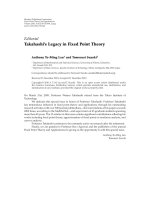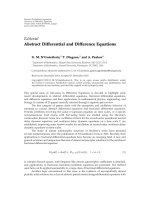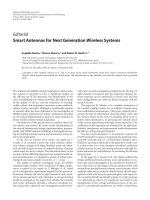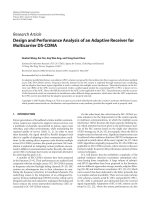Báo cáo hóa học: " Editorial Adaptive Partial-Update and Sparse System Identification" docx
Bạn đang xem bản rút gọn của tài liệu. Xem và tải ngay bản đầy đủ của tài liệu tại đây (425.55 KB, 2 trang )
Hindawi Publishing Corporation
EURASIP Journal on Audio, Speech, and Music Processing
Volume 2007, Article ID 12046, 2 pages
doi:10.1155/2007/12046
Editorial
Adaptive Partial-Update and Sparse System Identification
Kutluyıl Do
˘
ganc¸ay
1
and Patrick A. Naylor
2
1
School of Electrical and Information Engineering, University of South Australia, Mawson Lakes, South Australia 5095, Australia
2
Department of Electrical and Electronic Engineering, Imperial College London, Exhibition Road, London SW7 2AZ, UK
Received 1 March 2007; Accepted 1 March 2007
Copyright © 2007 K. Do
˘
ganc¸ay and P. A. Naylor. This is an open access article distributed under the Creative Commons
Attribution License, which permits unrestricted use, distribution, and reproduction in any medium, provided the original work is
properly cited.
System identification is an important task in many applica-
tion areas including, for example, telecommunications, con-
trol engineering, sensing, and acoustics. It would be widely
accepted that the science for identification of stationary and
dynamic systems is mature. However, several new applica-
tions have recently become of heightened interest for which
system identification needs to be performed on high-order
moving average systems that are either sparse in the time
domain or need to be estimated using sparse computation
due to complexity constraints. In this special issue, we have
brought together a collection of articles on recent work in
this field giving specific consideration to (a) algorithms for
identification of sparse systems and (b) algorithms that ex-
ploit sparseness in the coefficient update domain. The dis-
tinction between these two types of sparseness is important,
as we hope will become clear to the reader in the main body
of the special issue.
A driving force behind the development of algorithms for
sparse system identification in telecommunications has been
echo cancellation in packet switched telephone networks.
The increasing popularity of packet-switched telephony has
led to a need for the integration of older analog systems with,
for example, IP or ATM networks. Network gateways enable
the interconnection of such networks and provide echo can-
cellation. In such systems, the hybrid echo response is de-
layed by an unknown bulk delay due to propagation through
the network. The overall effect is, therefore, that an “active”
region associated with the true hybrid echo response occurs
with an unknown delay within an overall response window
that has to be sufficiently long to accommodate the worst
case bulk delay. In the context of network echo cancellation
the direct application of well-known algorithms, such as nor-
malized least-mean-square (NLMS), to sparse system identi-
fication gives unsatisfactory performance when the echo re-
sponse is sparse. This is because the adaptive algorithm has
to operate on a long filter and the coefficient noise for near-
zero-valued coefficients in the inactive regions is relatively
large. To address this problem, the concept of proportionate
updating was introduced.
An important consideration for adaptive filters is the
computational complexity that increases with the number of
coefficients to be updated per sampling period. A straight-
forward approach to complexity reduction is to update only
a s mall number of filter coefficients at every iteration. This
approach is termed partial-update adaptive filtering. Two key
questions arise in the context of partial updating. Firstly, con-
sideration must be given as to how to choose which coeffi-
cients to update. Secondly, the performance and complexity
of the partial update approach must be compared with the
standard full update algorithms in order to assess the cost-to-
benefit ratio for the partial update schemes. Usually, a com-
promise has to be made between affordable complexity and
desired convergence speed.
We have grouped the papers in this special issue into
four areas. The first area is sparse system identification and
comprises three papers. In “Set-membership proportion-
ate affine projection algorithms,” Stefan Werner et al. de-
velop affine projection algorithms with proportionate update
and set membership fi ltering. Proportionate updates facil-
itate fast convergence for sparse systems, and set member-
ship filtering reduces the update complexity. The second pa-
per in this area is “Wavelet-based MPNLMS adaptive algo-
rithm for network echo cancellation” by H. Deng and M.
Doroslova
ˇ
cki, which develops a wavelet-domain µ-law pro-
portionate NLMS algorithm for identification and cancelling
of sparse telephone network echoes. This work exploits the
whitening and good time-frequency localisation properties
of the wavelet transform to speed up the convergence for
coloured input signals and to retain sparseness of echo re-
sponse in the wavelet transform domain. In “A low delay and
2 EURASIP Journal on Audio, Speech, and Music Processing
fast converging improved proportionate algorithm for sparse
system identification,” Andy W. H. Khong et al. propose a
multidelay filter (MDF) implementation for improved pro-
portionate NLMS for sparse system identification, inheriting
the beneficial properties of both; namely, fast convergence
and computational efficiency coupled with low bulk delay.
As the authors show, the MDF implementation is nontrivial
and requires time-domain coefficient updating.
The second area of papers is partial-update active noise
control. In the first paper in this area “Analysis of tran-
sient and steady-state behavior of a multichannel filtered-
x partial-error affine projection algorithm,” A. Carini and
S. L. Sicuranza apply partial-error complexity reduction to
filtered-x affine projection algorithm for multichannel ac-
tive noise control, and provide a comprehensive analysis of
the transient and steady-state behaviour of the adaptive algo-
rithm drawing on energy conservation. In “Step size bound
of the sequential partial update LMS algorithm with peri-
odic input signals” Pedro Ramos et al. show that for pe-
riodic input signals the sequential partial update LMS and
filtered-x LMS algorithms can achieve the same convergence
performance as their full-update counterparts by increasing
the step-size appropriately. This essentially avoids any con-
vergence penalty associated with sequential updating.
The third area focuses on general partial update algo-
rithms. In the first paper in this area, “Detection guided
fast affine projection channel estimator for speech appli-
cations,” Yan Wu Jennifer et al. consider detection guided
identification of active taps in a long acoustic echo chan-
nel in order to shorten the actual channel and integrate it
into the fast affine projection algorithm to attain faster con-
vergence. The proposed algorithm is well suited for highly
correlated input signals such as speech signals. In “Efficient
multichannel NLMS implementation for acoustic echo can-
cellation,” Fredric Lindstrom et al. propose a multichannel
acoustic echo cancellation algorithm based on normalized
least-mean-square with partial updates favouring filters with
largest misadjustment.
The final area is devoted to blind source separation. In
“Time domain convolutive blind source separation employ-
ing selective-tap adaptive algorithms,” Q. Pan and T. Aboul-
nasr propose time-domain convolutive blind source separa-
tion algorithms employing M-max and exclusive maximum
selective-tap techniques. The resulting algorithms have re-
duced complexity and improved convergence performance
thanks to partial updating and reduced interchannel co-
herence. In the final paper “Underdetermined blind audio
source separation using modal decomposition,” Abdeljalil
A
¨
ıssa-El-Bey et al. present a novel blind source separation
algorithm for audio signals using modal decomposition. In
addition to instantaneous mixing, the authors consider con-
volutive mixing and exploit the sparseness of audio signals
to identify the channel responses before applying modal de-
composition.
In summary, we can say that sparseness in the context
of adaptive filtering presents both challenges and opportu-
nities. Standard adaptive algorithms suffer a degra dation in
performance when the system to be identified is sparse. This
has created the need for new algorithms for sparse adap-
tive filtering—a challenge that has been well met to date for
the particular applications addressed. When sparseness ex-
ists, or can be safely assumed, in input signals, this can be
exploited to achieve both computational savings in partial
update schemes and, in certain specific cases, performance
improvements. There remain several open research questions
in this context and we look forward to an ongoing research
effort in the scientific community and opportunities for al-
gorithm deployment in real-time applications.
ACKNOWLEDGMENTS
This special issue has arisen as a result of the high levels of
interest shown at a special session on this topic at EUSIPCO
2005 in Antalya, Turkey. It has been a great pr ivilege to act as
guest editors for this special issue and we extend our grateful
thanks to all the authors and the publisher.
Kutluyıl Do
˘
ganc¸ay
Patrick A. Naylor









